2007 Lexus GS350 power steering
[x] Cancel search: power steeringPage 2 of 562
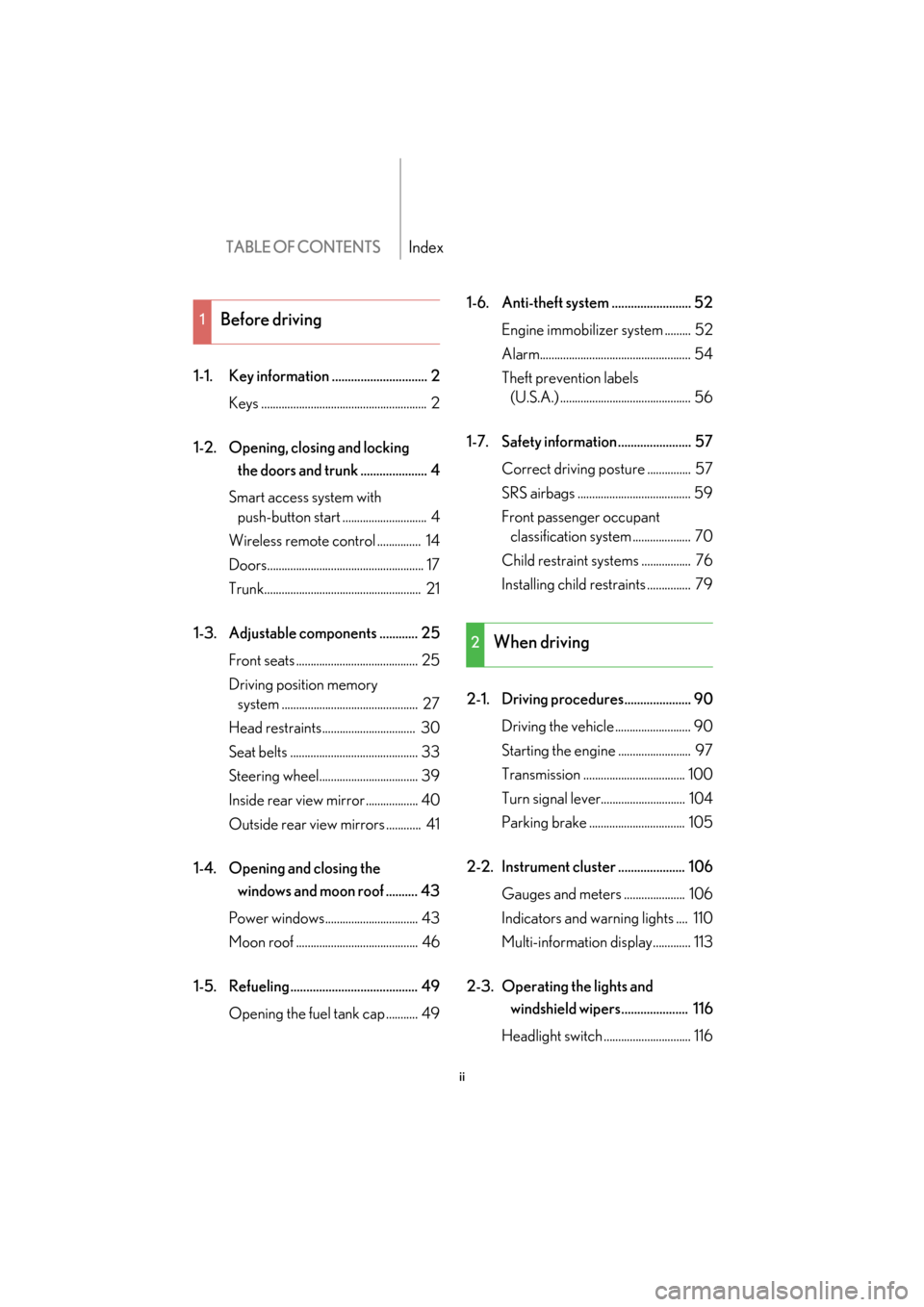
TABLE OF CONTENTSIndex
ii
1-1. Key information .............................. 2Keys ......................................................... 2
1-2. Opening, closing and locking
the doors and trunk ..................... 4
Smart access system with push-button start ............................. 4
Wireless remote control ............... 14
Doors...................................................... 17
Trunk...................................................... 21
1-3. Adjustable components ............ 25 Front seats .......................................... 25
Driving position memory
system ............................................... 27
Head restraints................................ 30
Seat belts ............................................ 33
Steering wheel.................................. 39
Inside rear view mirror .................. 40
Outside rear view mirrors ............ 41
1-4. Opening and closing the
windows and moon roof .......... 43
Power windows................................ 43
Moon roof .......................................... 46
1-5. Refueling ........................................ 49 Opening the fuel tank cap ........... 49 1-6. Anti-theft system ......................... 52
Engine immobilizer system ......... 52
Alarm.................................................... 54
Theft prevention labels
(U.S.A.) ............................................. 56
1-7. Safety information ....................... 57 Correct driving posture ............... 57
SRS airbags ....................................... 59
Front passenger occupant
classification system .................... 70
Child restraint sy stems ................. 76
Installing child restraints ............... 79
2-1. Driving procedures..................... 90 Driving the vehicle .......................... 90
Starting the engine ......................... 97
Transmission ................................... 100
Turn signal lever............................. 104
Parking brake ................................. 105
2-2. Instrument cluster ..................... 106 Gauges and meters ..................... 106
Indicators and warning lights .... 110
Multi-information display............. 113
2-3. Operating the lights and
windshield wipers..................... 116
Headlight switch .............................. 116
1Before driving
2When driving
Page 21 of 562
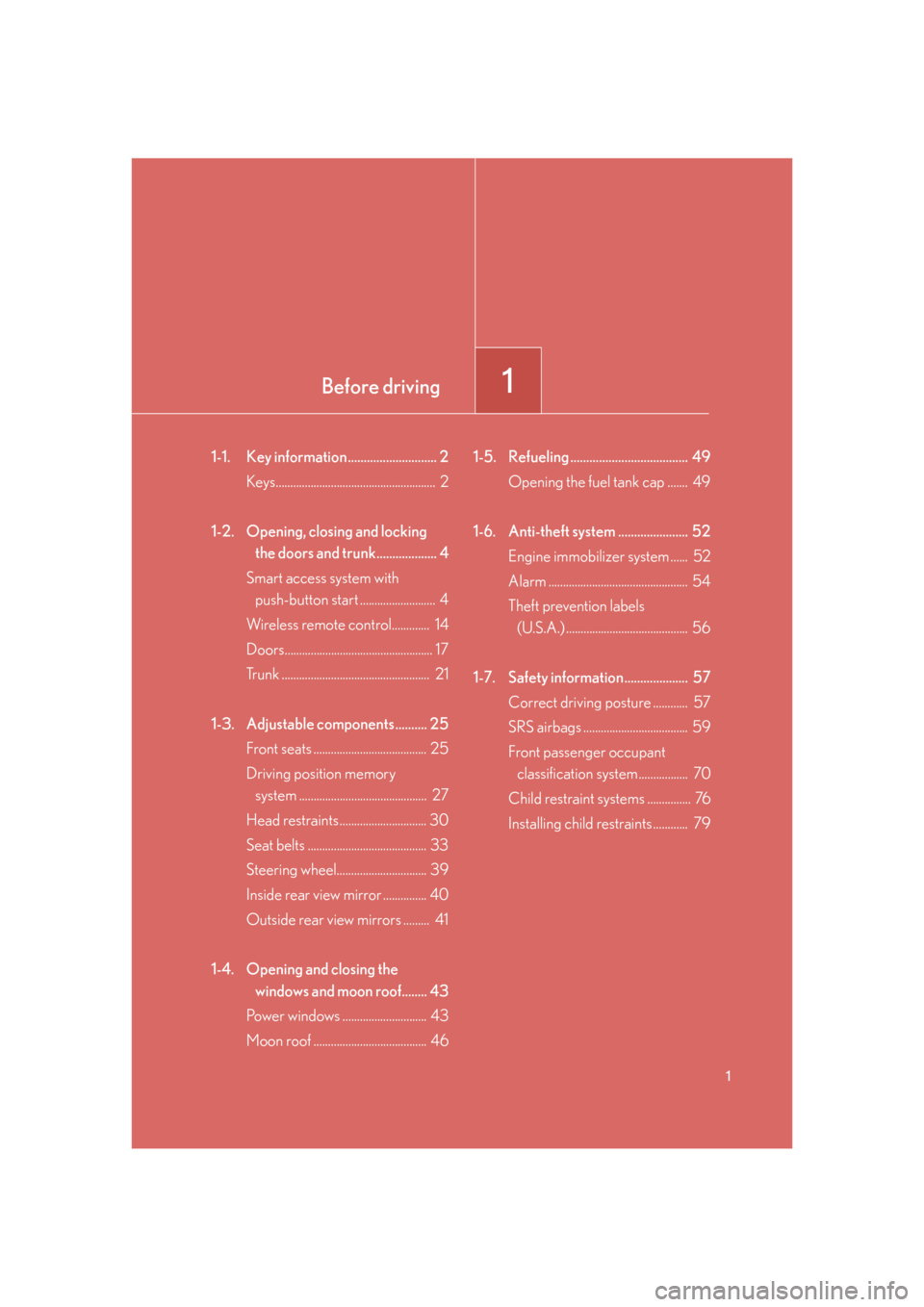
Before driving1
1
1-1. Key information ............................ 2Keys....................................................... 2
1-2. Opening, closing and locking
the doors and trunk................... 4
Smart access system with
push-button start .......................... 4
Wireless remote control............. 14
Doors................................................... 17
Trunk ................................................... 21
1-3. Adjustable components .......... 25 Front seats ....................................... 25
Driving position memory
system ............................................ 27
Head restraints .............................. 30
Seat belts ......................................... 33
Steering wheel............................... 39
Inside rear view mirror ............... 40
Outside rear view mirrors ......... 41
1-4. Opening and closing the
windows and moon roof........ 43
Power windows ............................. 43
Moon roof ....................................... 46 1-5. Refueling ..................................... 49
Opening the fuel tank cap ....... 49
1-6. Anti-theft system ...................... 52 Engine immobilizer system ...... 52
Alarm ................................................ 54
Theft prevention labels
(U.S.A.) .......................................... 56
1-7. Safety information.................... 57 Correct driving posture ............ 57
SRS airbags .................................... 59
Front passenger occupant
classification system................. 70
Child restraint systems ............... 76
Installing child restraints ............ 79
Page 49 of 562
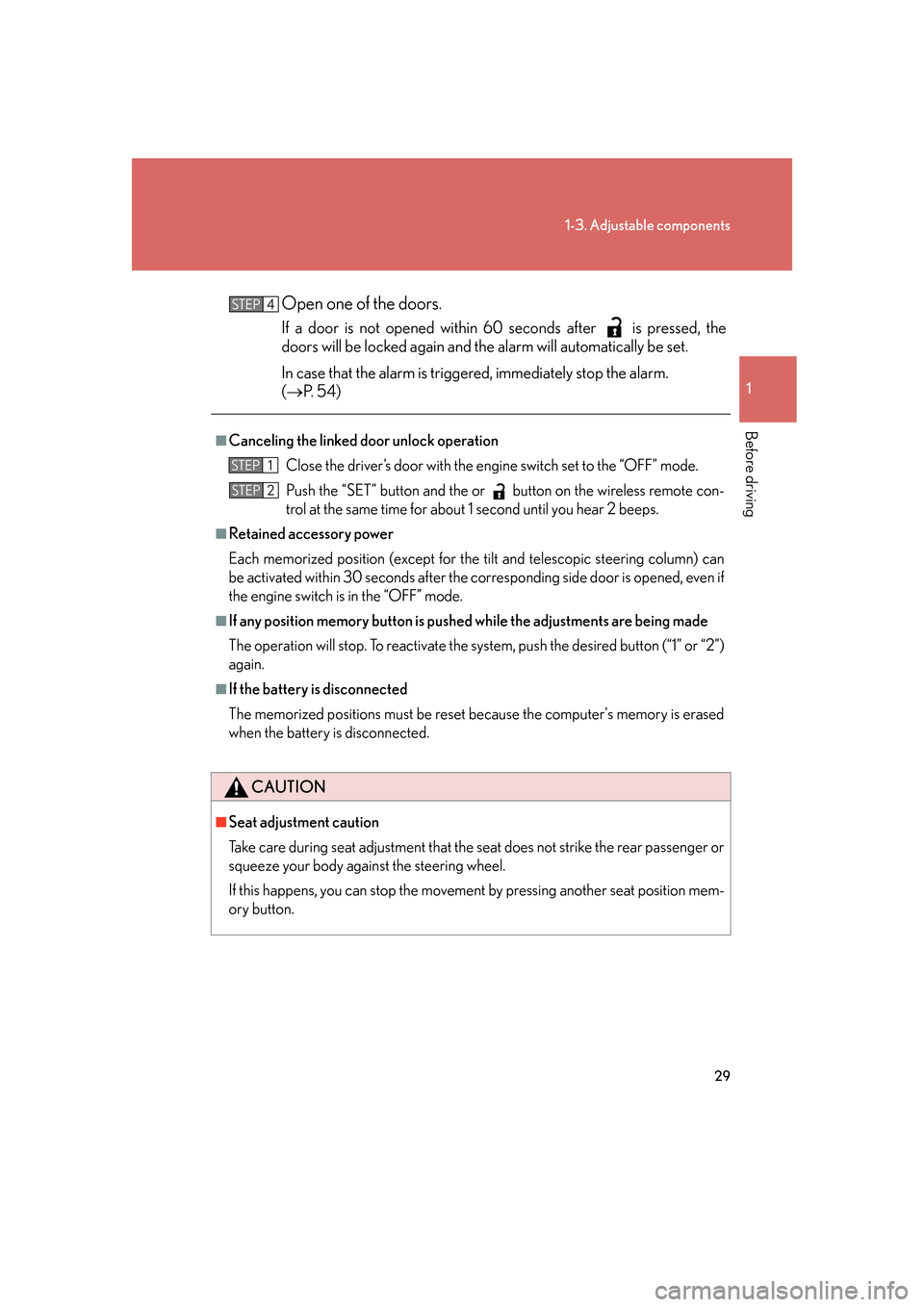
29
1-3. Adjustable components
1
Before driving
Open one of the doors.
If a door is not opened within 60 seconds after is pressed, the
doors will be locked again and the alarm will automatically be set.
In case that the alarm is triggered, immediately stop the alarm.
( P. 5 4 )
■Canceling the linked do or unlock operation
Close the driver’s door with the en gine switch set
to the “OFF” mode.
Push the “SET” button and the or button on the wireless remote con-
trol at the same time for about 1 second until you hear 2 beeps.
■Retained accessory power
Each memorized position (except for the tilt and telescopic steering column) can
b
e activated within 30 seconds after the co rresponding side door is opened, even if
the engine switch is in the “OFF” mode.
■If any position memory button is push ed while the adjustments are being made
The operation will stop. To reactivate the sy st
em, push the desired button (“1” or “2”)
again.
■If the battery is disconnected
The memorized positions must be reset be cause the computer's memory is erased
when the battery is disconnected.
CAUTION
■Seat adjustment caution
Take care during seat adjustment that the seat does not strike the rear passenger or
squeeze your body against the steering wheel.
If this happens, you can stop the movement by pressing another seat position mem-
ory button.
STEP4
STEP1
STEP2
Page 62 of 562
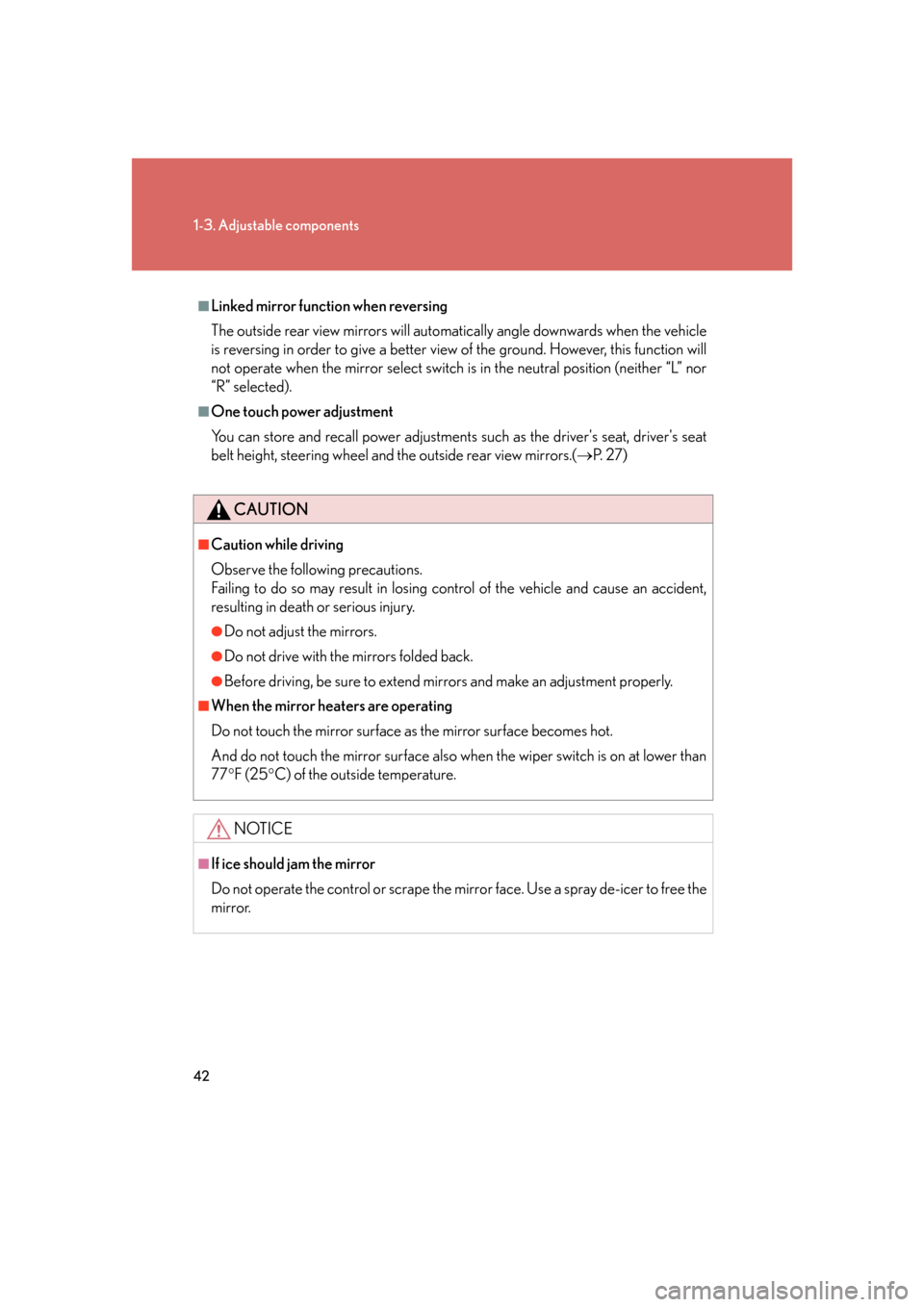
42
1-3. Adjustable components
■Linked mirror function when reversing
The outside rear view mirrors will automatically angle downwards when the vehicle
is reversing in order to give a better view of the ground. However, this function will
not operate when the mirror select switch is in the neutral position (neither “L” nor
“R” selected).
■One touch power adjustment
You can store and recall power adjustments su ch as the driver's seat, driver's seat
belt height, steering wheel and the outside rear view mirrors.( P. 2 7 )
CAUTION
■Caution while driving
Observe the following precautions.
Failing to do so may result in losing control of the vehicle and cause an accident,
resulting in death or serious injury.
●Do not adjust the mirrors.
●Do not drive with the mirrors folded back.
●Before driving, be sure to extend mirrors and make an adjustment properly.
■When the mirror heaters are operating
Do not touch the mirror surface as the mirror surface becomes hot.
And do not touch the mirror surface also wh en the wiper switch is on at lower than
77 F (25 C) of the outside temperature.
NOTICE
■If ice should jam the mirror
Do not operate the control or scrape the mi rror face. Use a spray de-icer to free the
mirror.
Page 81 of 562
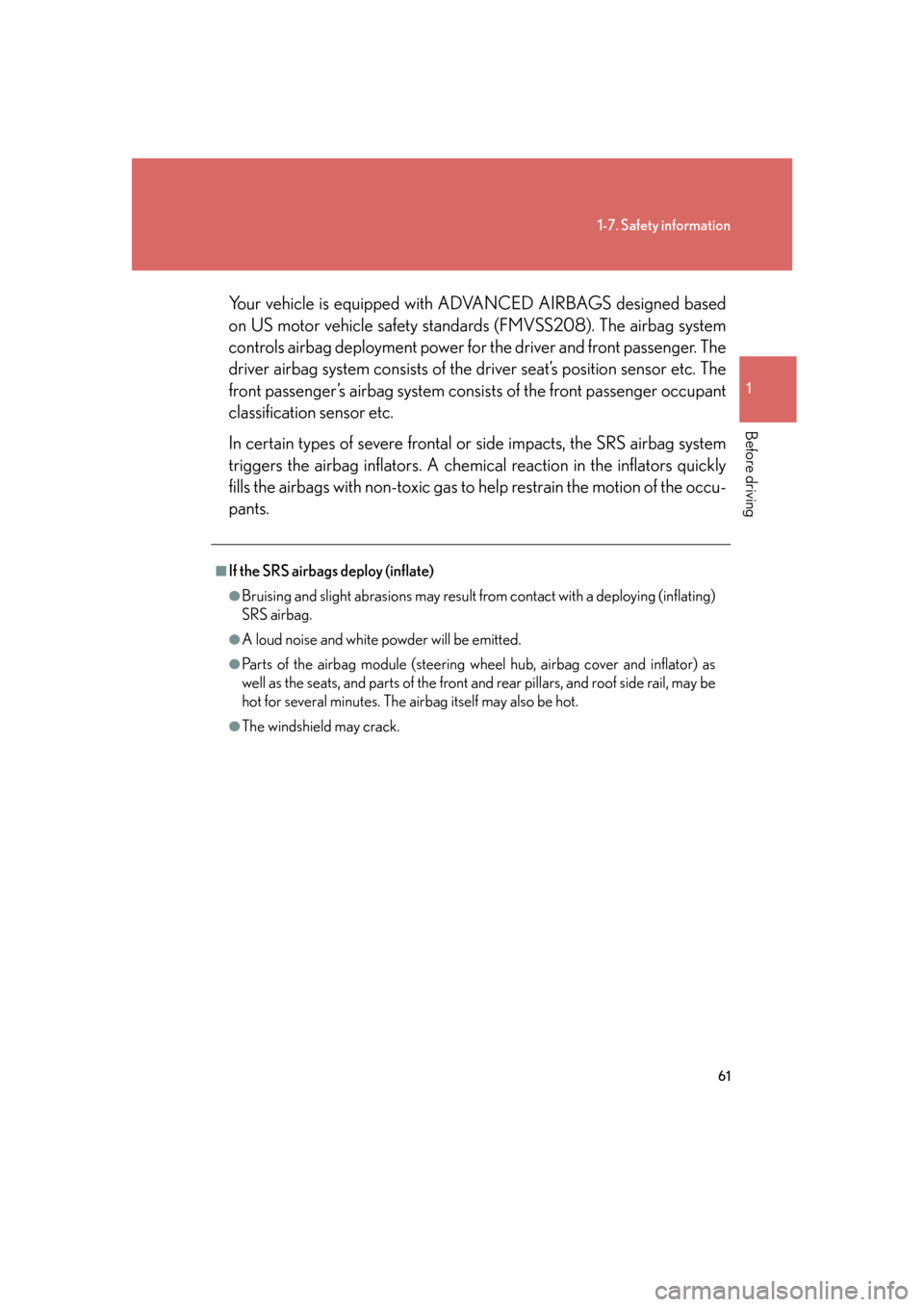
61
1-7. Safety information
1
Before driving
Your vehicle is equipped with ADVANCED AIRBAGS designed based
on US motor vehicle sa fety standards (FMVSS208). The airbag system
controls airbag deployment power for the driver and front passenger. The
driver airbag system consists of the driver seat’s position sensor etc. The
front passenger’s airbag system consist s of the front passenger occupant
classification sensor etc.
In certain types of severe frontal or side impacts, the SRS airbag s
ystem
triggers the airbag inflators. A chemica l reaction in the inflators quickly
fills the airbags with non-toxic gas to help restrain the motion of the occu -
pants.
■If the SRS airbags deploy (inflate)
●Bruising and slight abrasions may result from contact with a deploying (inflating)
SRS airbag.
●A loud noise and white powder will be emitted.
●Parts of the airbag module (steering wheel hub, airbag cover and inflator) as
well as the seats, and parts of the front and rear pillars, and roof side rail, may be
hot for several minutes. The airbag itself may also be hot.
●The windshield may crack.
Page 113 of 562
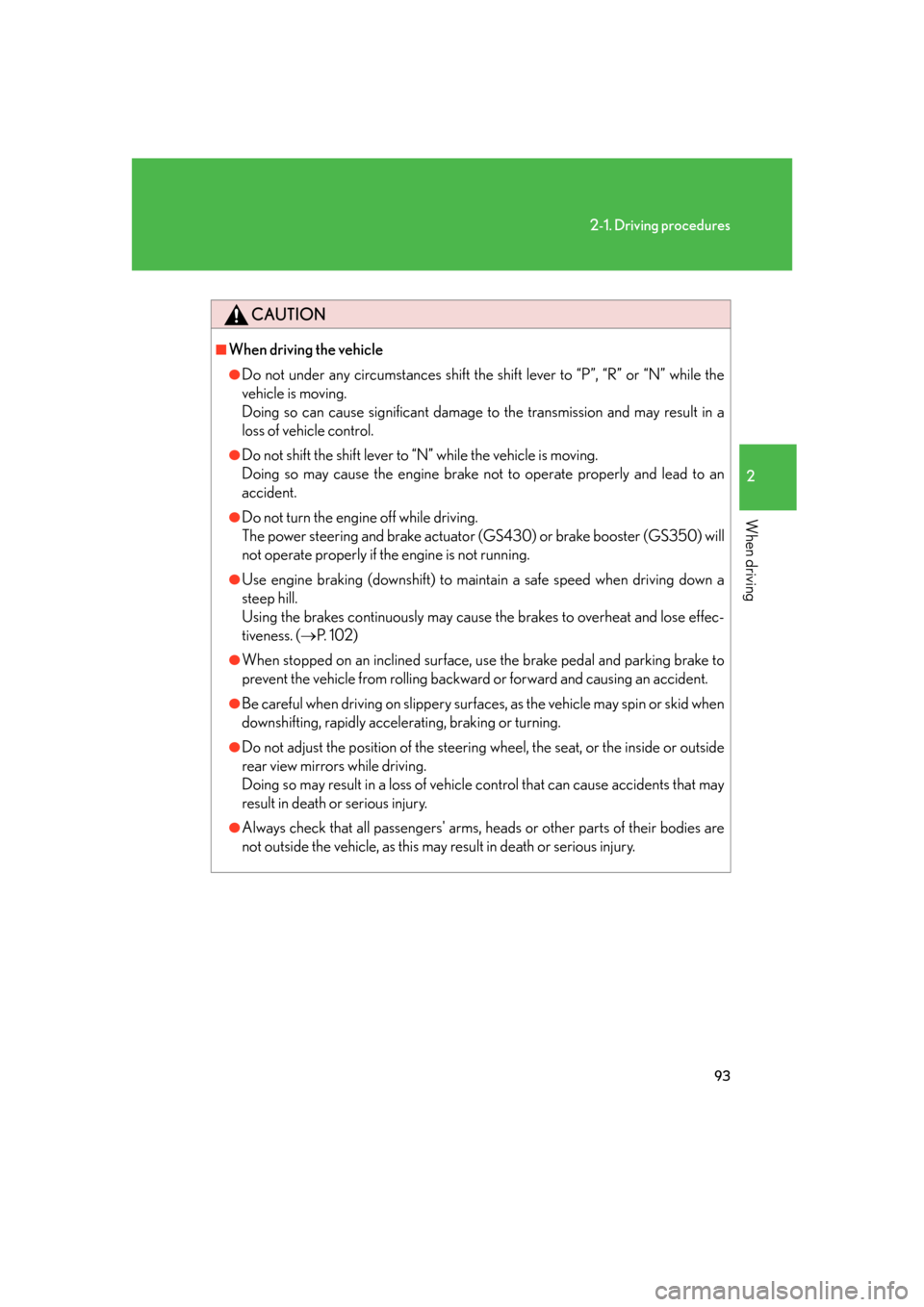
93
2-1. Driving procedures
2
When driving
CAUTION
■When driving the vehicle
●Do not under any circumstances shift the shift lever to “P”, “R” or “N” while the
vehicle is moving.
Doing so can cause significant damage to the transmission and may result in a
loss of vehicle control.
●Do not shift the shift lever to “N” while the vehicle is moving.
Doing so may cause the engine brake not to operate properly and lead to an
accident.
●Do not turn the engine off while driving.
The power steering and brake actuator (GS430) or brake booster (GS350) will
not operate properly if the engine is not running.
●Use engine braking (downshift) to maintain a safe speed when driving down a
steep hill.
Using the brakes continuously may cause the brakes to overheat and lose effec-
tiveness. ( P. 1 0 2 )
●When stopped on an inclined surface, use the brake pedal and parking brake to
prevent the vehicle from rolling backward or forward and causing an accident.
●Be careful when driving on slippery surfaces, as the vehicle may spin or skid when
downshifting, rapidly accelerating, braking or turning.
●Do not adjust the position of the steering wheel, the seat, or the inside or outside
rear view mirrors while driving.
Doing so may result in a loss of vehicle control that can cause accidents that may
result in death or serious injury.
●Always check that all passengers' arms, heads or other parts of their bodies are
not outside the vehicle, as this may result in death or serious injury.
Page 116 of 562
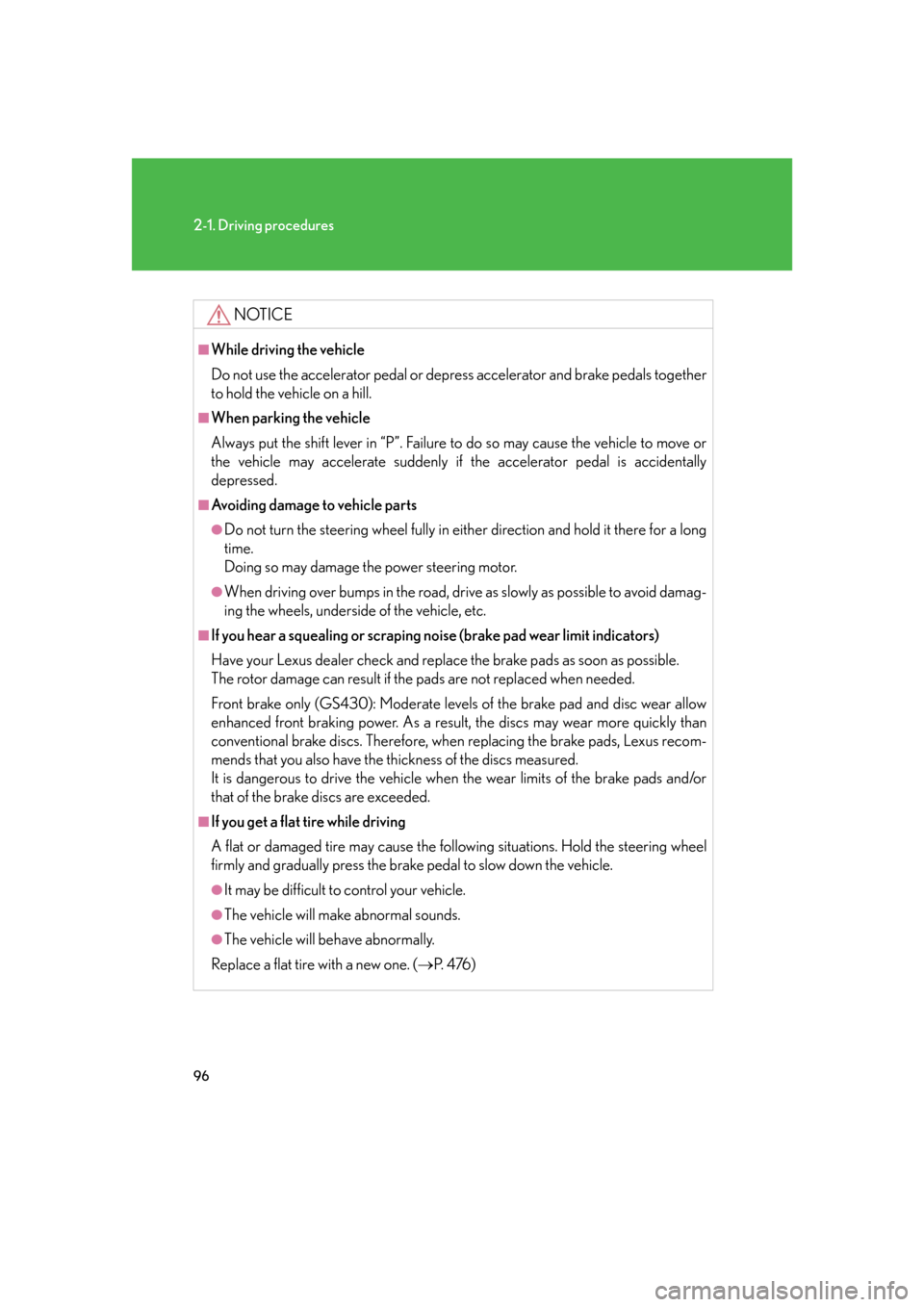
96
2-1. Driving procedures
NOTICE
■While driving the vehicle
Do not use the accelerator pedal or depress accelerator and brake pedals together
to hold the vehicle on a hill.
■When parking the vehicle
Always put the shift lever in “P”. Failure to do so may cause the vehicle to move or
the vehicle may accelerate suddenly if the accelerator pedal is accidentally
depressed.
■Avoiding damage to vehicle parts
●Do not turn the steering wheel fully in either direction and hold it there for a long
time.
Doing so may damage the power steering motor.
●When driving over bumps in the road, drive as slowly as possible to avoid damag-
ing the wheels, underside of the vehicle, etc.
■If you hear a squealing or scraping no ise (brake pad wear limit indicators)
Have your Lexus dealer check and replac e the brake pads as soon as possible.
The rotor damage can result if the pads are not replaced when needed.
Front brake only (GS430): Moderate levels of the brake pad and disc wear allow
enhanced front braking power. As a result , the discs may wear more quickly than
conventional brake discs. Therefore, when replacing the brake pads, Lexus recom-
mends that you also have the th ickness of the discs measured.
It is dangerous to drive the vehicle when the wear limits of the brake pads and/or
that of the brake discs are exceeded.
■If you get a flat tire while driving
A flat or damaged tire may cause the following situations. Hold the steering wheel
firmly and gradually press the brak e pedal to slow down the vehicle.
●It may be difficult to control your vehicle.
●The vehicle will make abnormal sounds.
●The vehicle will behave abnormally.
Replace a flat tire with a new one. ( P. 4 76 )
Page 179 of 562
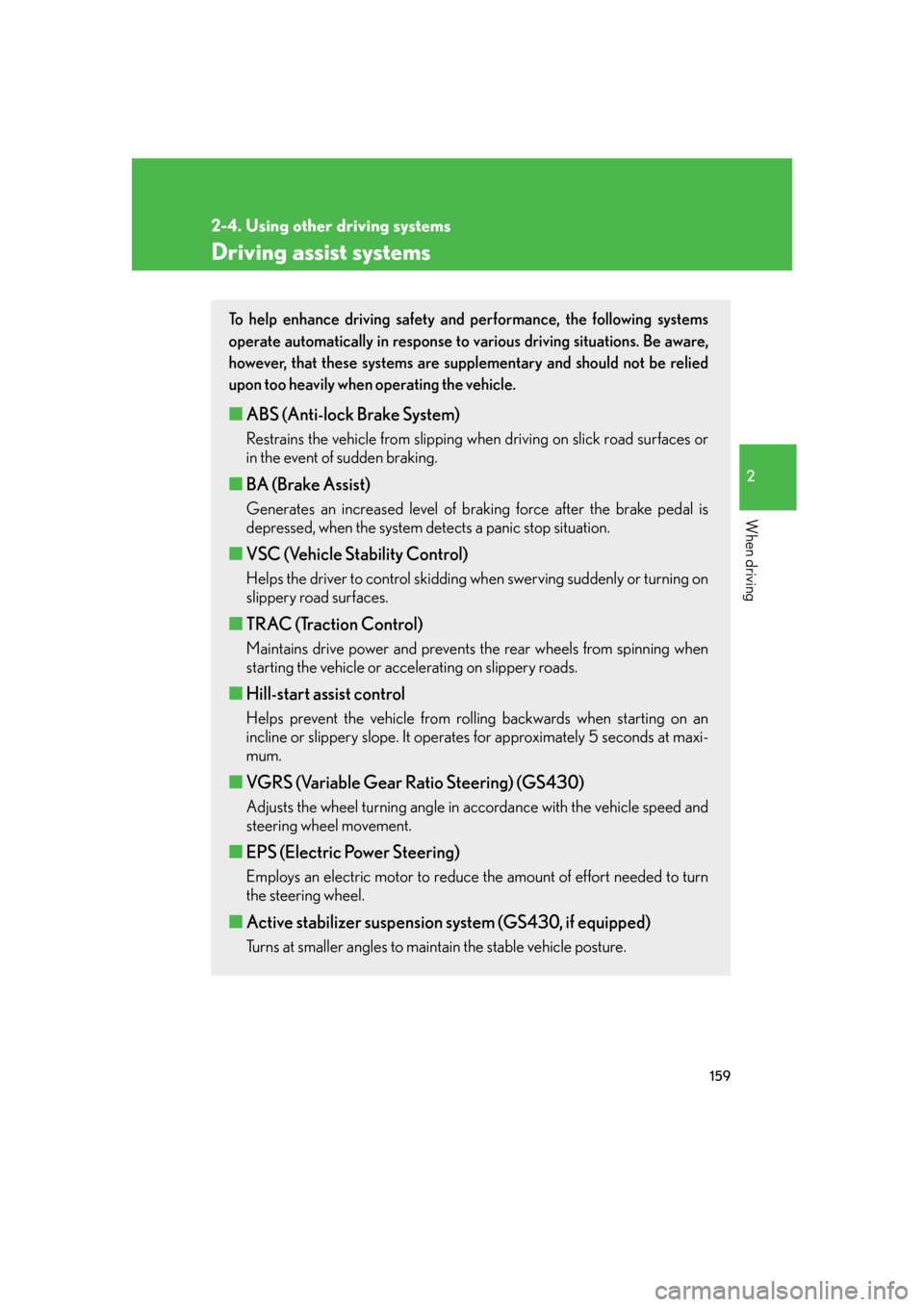
159
2-4. Using other driving systems
2
When driving
Driving assist systems
To help enhance driving safety and performance, the following systems
operate automatically in response to various driving situations. Be aware,
however, that these systems are supplementary and should not be relied
upon too heavily when operating the vehicle.
■ABS (Anti-lock Brake System)
Restrains the vehicle from slipping when driving on slick road surfaces or
in the event of sudden braking.
■BA (Brake Assist)
Generates an increased level of braking force after the brake pedal is
depressed, when the system detects a panic stop situation.
■VSC (Vehicle Stability Control)
Helps the driver to control skidding wh en swerving suddenly or turning on
slippery road surfaces.
■ TRAC (Traction Control)
Maintains drive power and prevents the rear wheels from spinning when
starting the vehicle or accelerating on slippery roads.
■Hill-start assist control
Helps prevent the vehicle from rolling backwards when starting on an
incline or slippery slope. It operat es for approximately 5 seconds at maxi -
mum.
■ VGRS (Variable Gear Ratio Steering) (GS430)
Adjusts the wheel turning angle in accordance with the vehicle speed and
steering wheel movement.
■EPS (Electric Power Steering)
Employs an electric motor to reduce the amount of effort needed to turn
the steering wheel.
■Active stabilizer suspension system (GS430, if equipped)
Turns at smaller angles to main tain the stable vehicle posture.